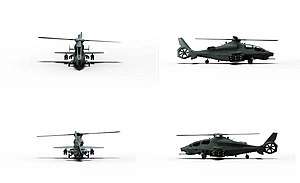Bell 360 Invictus
The Bell 360 Invictus is a proposed helicopter design intended to meet the United States Army requirement for a Future Attack Reconnaissance Aircraft (FARA). It is based on technology from the Bell 525 Relentless.[1]
| Bell 360 Invictus | |
|---|---|
 | |
| Role | Reconnaissance and attack helicopter |
| National origin | United States |
| Manufacturer | Bell Textron |
| First flight | 2023 (planned) |
Design and development
Scott C. Donnelly, CEO of Textron, has said in April 2019 that the 360 will be based on the 525.[1][2] The 360 and 525 will share an articulated rotor system, although the 360, which will only seat two (a pilot and gunner), will use a single engine and a four-blade rotor, whereas the 525 uses twin engines and a five-blade rotor and has a nineteen passenger capacity.[3] Bell has since announced it is developing the 360 with Collins Aerospace.[4]
The design was unveiled on 1 October 2019, showing a two-seat tandem cockpit, with sighting optics and/or laser designator above a 20mm cannon gun turret at the chin position below the cockpit, mid-mounted stub wings below the shrouded rotor hub and four 40 foot (12 m) diameter rotor blades, an active horizontal stabilizer and a tilted and shrouded tail rotor. Missiles are mounted on integrated launchers.[1] The rotor diameter is dictated by US Army requirements, which specified that maximum diameter for FARA candidates to allow the rotorcraft to fit between buildings on future battlefields.[3] Its main engine will be a single General Electric T901 turboshaft engine, with supplemental power from a Pratt & Whitney PW207D1 turboshaft.[5]
The US Army requirement calls for a cruising speed in excess of 180 knots (330 km/h), and the 360 is intended to meet this;[1] the 525 rotor system has been tested to exceed 200 knots (370 km/h).[3] The stub wings are intended to provide lift equivalent to approximately 50% of the weight of the aircraft at moderate to high speed.[1] Combat radius will be 135 nautical miles (250 km) with at least 90 minutes time on station. It will use fly-by-wire control.[6]
Bell unveiled a full-scale mockup of the 360 at the Association of the United States Army annual show beginning 14 October 2019.[1][7]
Specifications (Bell 360)
Data from [5]
General characteristics
- Crew: two
- Powerplant: 1 × General Electric T901 turboshaft (main powerplant)
- Powerplant: 1 × Pratt & Whitney PW207D1 turboshaft, 586 shp (439 kW) (supplemental power unit)
Performance
- Cruise speed: 210 mph (330 km/h, 180 kn)
See also
Related development
Aircraft of comparable role, configuration and era
References
- Bell unshrouds Invictus, its answer for the US Army’s future attack recon aircraft, Jen Judson, Defense News, 2019-10-02
- Bell FARA Offering Based on 525 Technology, Company Says, Frank Wolfe, Rotor & Wing International, 2019-04-29, accessed 2019-10-03
- Reim, Garrett (2 October 2019). "ANALYSIS: Bell reveals 360 Invictus proposal for US Army contest". Flight Global. Retrieved 14 October 2019.
- Tadjdeh, Yasmin (9 October 2019). "Army's Future Attack Recon Aircraft Gains Momentum". National Defense. Retrieved 15 October 2019.
- Reim, Garrett (16 December 2019). "Bell discloses booster engine for 360 Invictus". Flight Global. Retrieved 16 December 2019.
The helicopter is able to pull power from the supplemental turboshaft via a 'patent pending clutching mechanism,' he says. The PW207 produces 586shp (439kW). It would be mounted on the right side of the Invictus 360, with its exhaust exiting out of the right-side infrared signature suppression system.
- Lethal. Sustainable. Bell announces 360 Invictus for U.S. Army future attack reconnaissance aircraft competition, Textron media release, 2019-10-02
- "Video: Bell shows off the full-scale Invictus model at AUSA". Army Times. 15 October 2019. Retrieved 15 October 2019.